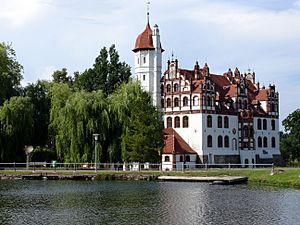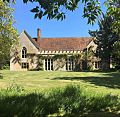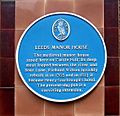Manor house facts for kids

A manor house was a special kind of large house in the countryside. It was the main building of a manor, which was a large area of land owned by a lord. These houses were often home to important families, like the gentry, who were wealthy landowners. Sometimes, they were also called "fortified manor-houses" because they had some defenses, but not as strong as a castle.
Contents
What is a Manor House?
A manor house was the home of a feudal lord. This lord owned a lot of land and many people worked for him. If a lord owned many manors, he might only visit each house sometimes.
Even though manor houses were not as strongly built as castles, many had some protection. They were often surrounded by walls or ditches filled with water, like a moat. Farm buildings were often inside these protective walls too. Some manor houses even had small gatehouses and watchtowers to keep watch.
The most important room in a manor house was its great hall. This large room was used for meals, meetings, and gatherings.
How Manor Houses Changed Over Time
By the early 1500s, manor houses and even small castles started to change. They became more comfortable and stylish homes for country gentlemen. This change happened a lot in the late 1500s.
This period led to many beautiful Renaissance châteaux in France. In England, it created many country mansions in the Elizabethan and Jacobean styles. These new homes were more about showing wealth and comfort than about defense.
Manor Houses in France
In France, people often use the words château or manoir to describe a French manor house. Another French term, maison-forte, means a strongly fortified manor house. In some parts of western France, like Brittany and Normandy, certain large manors had very good ways to protect themselves.
Modern Use of the Term
Today, the word "manor" or "manor house" is sometimes used differently. Especially outside Europe, it can simply mean a large country house. It might also refer to any house that looks like a traditional manor house. In modern use, it doesn't always refer to the historical meaning of a lord's estate.
Related pages
Images for kids
-
The Abbey, Sutton Courtenay in Oxfordshire (previously Berkshire), considered to be a "textbook" example of the English medieval manor house
-
Markenfield Hall in North Yorkshire, a 14th-century manor house with moat and gatehouse
-
Ightham Mote, a 14th-century moated manor house in Kent, England
-
A 19th-century main building of the Hatanpää Manor in Tampere, Finland
-
Château de Trécesson, a 14th-century manor-house in Morbihan, Brittany
-
Schloss Machern (Machern Castle) near Leipzig is an example of a typical manor house, it evolved from a medieval castle which was originally protected by a water moat and later was converted into a baroque-style castle with typical architectural features of the period and one of the first English-style parks in Germany.
-
Biltmore Estate in North Carolina
See also
 In Spanish: Casa Señorial para niños
In Spanish: Casa Señorial para niños













